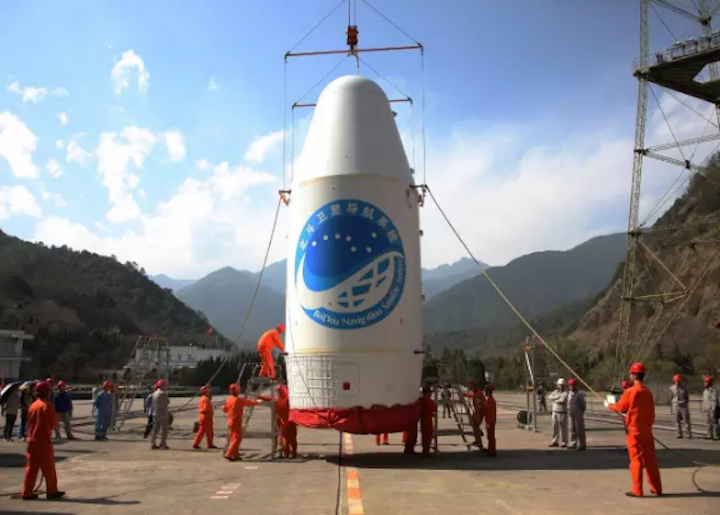
The Long March 3B/YZ-1, carrying Beidou satellites 28 and 29 to medium Earth orbit, lifts off from Xichang Satellite Launch Centre at 13:03 local time on February 12, 2018.
12.10.2018

A Beidou satellite inside the payload fairing and ready for stacking at Xichang in 2016. CASC
-
China is set to carry out its 28th orbital mission of 2018 with the launch of a pair of Beidou positioning, navigation and timing satellites from the Xichang Satellite Launch Centre on Monday, October 15.
The two Beidou-3 satellites will be launched by an enhanced Long March 3B launch vehicle using a Yuanzheng-1 upper stage for direct insertion into medium Earth orbits.
An airspace closure notice issued on Thursday indicates the launch, from Xichang in southwest China, will take place between 04:05 and 04:42 universal time on October 15 (12:05-12:42 local, 00:05-00:42 Eastern).
The satellites will be the 39th and 40th launched as part of China's Beidou system, following the launch of the first in 2000.

The Long March 3B/YZ-1, carrying Beidou satellites 28 and 29 to medium Earth orbit, lifts off from Xichang Satellite Launch Centre at 13:03 local time on February 12, 2018.
The Beidou-3 satellites are based on a satellite bus that features a phased array antenna for navigation signals and a laser retroreflector with a launch mass 1,014 kg, according to NasaSpaceFlight.
The spacecraft dimensions are given as 2.25 by 1.0 by 1.22 metres, with the satellites usually sent to operate in 21,400-21,500 km altitude orbits inclined by 55.5 degrees.

A Beidou-3 positioning and navigation satellite, which is to be launched into medium Earth orbit.
The completed system of 35 operational Beidou satellites will have 27 satellites in MEO at around 22,000 km altitude, five in geostationary orbit and three more in inclined geosynchronous orbits, at 35,786 km, providing global GNSS coverage with a positioning accuracy of 2.5 metres.
The Beidou navigation system, which takes its name from the Chinese asterism equivalent to the Plough or Big Dipper, is China's answer to the US Global Positioning System (GPS), Russia's GLONASS and Europe's Galileo GNSS constellations.
GNSS provide civilian applications such as navigation for shipping and road traffic, mapping and surveying, but also assist military forces from space, facilitating targeting, positioning and locating, and the synchronising of operations. The development of Beidou will end previous Chinese military reliance on GPS.

A range of Beidou applications according to the China Navigation Satellite Office.
With 27 launches so far in 2018, China has already passed its previous record for launches in a calendar year of 22, set in 2016. The main contractor for China's space programme stated at the start of 2018 it intends to launch up to 35 times this year.
Commercial actors including Expace and Landspace will add to the numbers with launches of Kuaizhou and Zhuque rockets.
Landspace's Zhuque-1 (Vermillion Bird-1), a three-stage solid-fuelled rocket, will attempt to be the first privately-developed orbital launch vehicle at the end of October.
China is still planning two more launches of Beidou satellites this year using the Long March 3B rocket following the upcoming Monday mission. The same launch vehicle will be used to launch the ground-breaking Chang'e-4 lunar far side landing and roving mission in December. Any issue with any of these launches will likely delay the launch of Chang'e-4.

The far side of the Moon and the distant Earth, imaged by the Chang'e-5T1 mission in 2014.